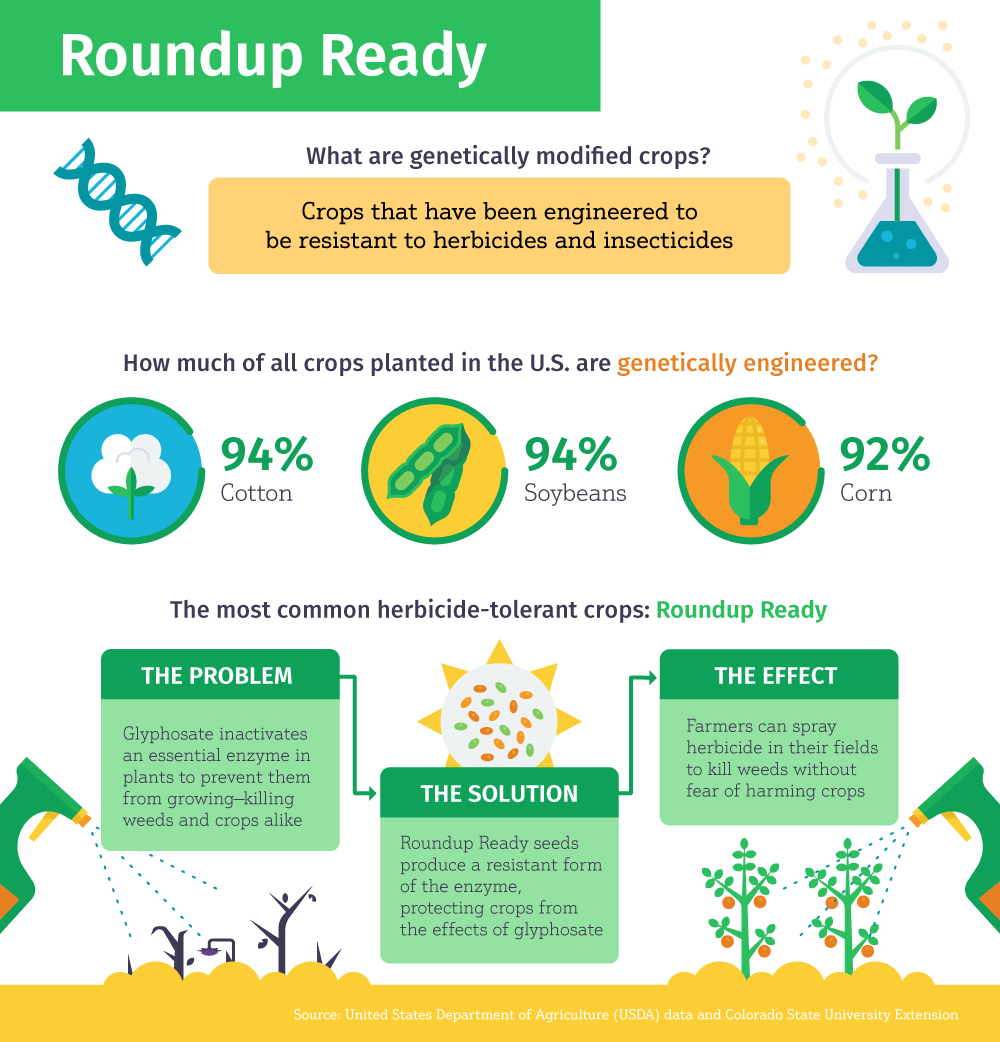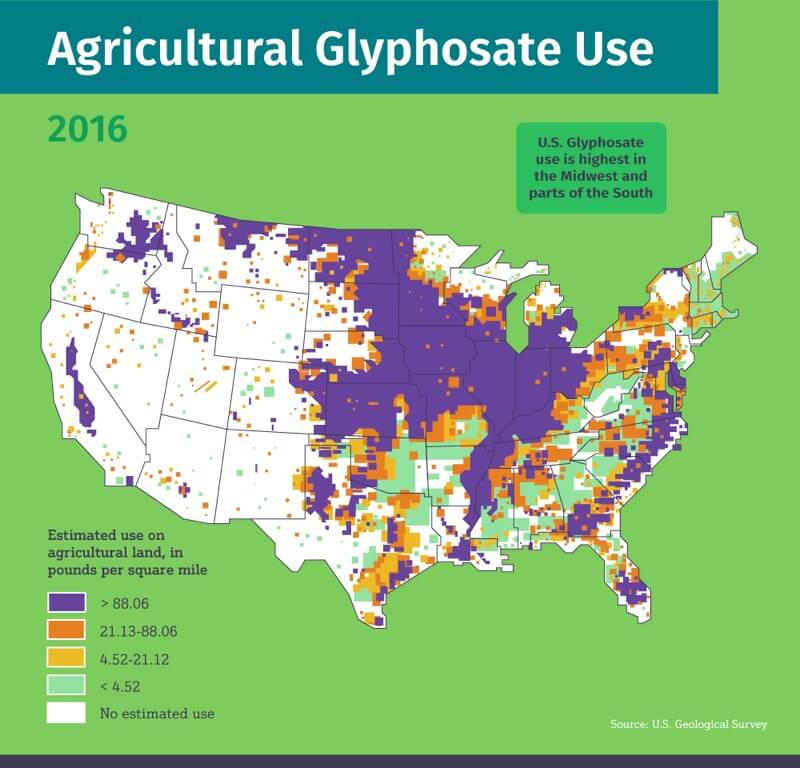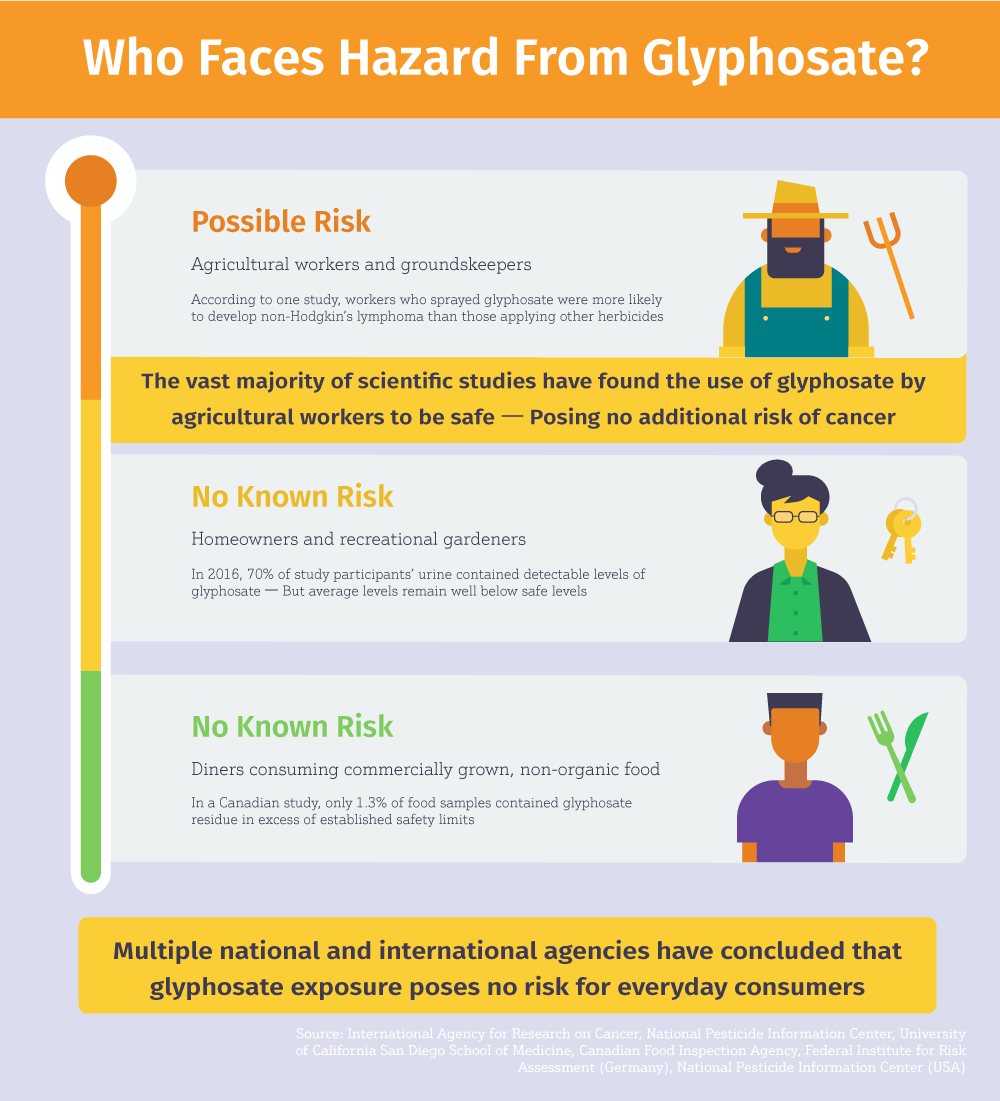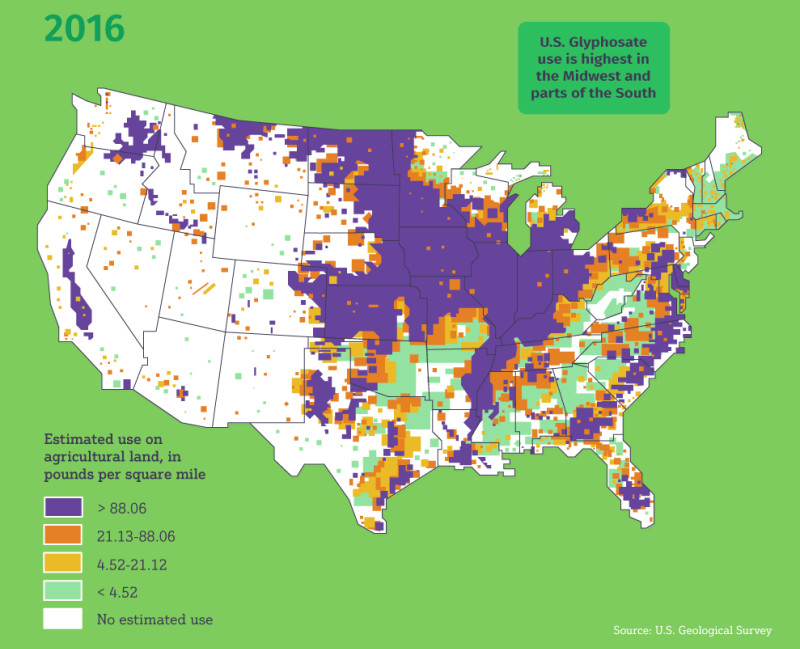Will Monsanto’s Weed Killer Give Me Cancer?
Glyphosate remains the world’s most commonly used herbicide. It comes in many forms, including as an acid and several salts. These can be either solids or an amber-colored liquid. There are over 750 products containing glyphosate for sale in the United States alone.
In this analysis and series of infographics, we look at the evolving legal trial timelines, human exposure, agricultural use, the science behind the product, genetically modified crops, the fight over glyphosate, its cancer risk, as well as the research behind glyphosate and its formulations.
Monsanto Faces Legal Challenge
The legal health issue began in 2014, when California school groundskeeper Dewayne Johnson was diagnosed with terminal non-Hodgkin’s lymphoma. Although he has outlived the median life expectancy of someone with the disease, Johnson’s doctors do not expect him to live beyond 2020.
After being recruited by a law firm looking for a test case challenging the safety of Roundup, Johnson alleged in 2016 that his cancer was caused by prolonged use of and contact with Roundup Pro and Ranger Pro glyphosate-based herbicides, both products owned by agricultural biotechnology giant Monsanto, now a division of Bayer. He sued Monsanto in the first ever lawsuit to go to trial alleging that glyphosate caused his cancer.
On August 10, 2018, the jury announced its verdict, awardeding Johnson $39 million in compensatory and $250 million in punitive damages. The jury concluded:
- The potential risks of Roundup Pro or Ranger Pro presented a “substantial danger” to users.
- Monsanto knew or should reasonably have known that Roundup Pro and Ranger Pro were dangerous or were likely to be dangerous.
- Roundup Pro or Ranger Pro had potential risks that were known or knowable in light of the scientific knowledge that was generally accepted in the scientific community.
- Monsanto failed to adequately warn of the danger or instruct on the safe use of Roundup Pro and Ranger Pro.
- Monsanto acted with malice or oppression.
Monsanto responded, asking the judge, Suzanne R. Bolanos, to overrule the jury’s verdict. At first, Bolanos’ tentative ruling favored Monsanto, stating: “Given the state of medical and scientific knowledge there is no clear and convincing evidence that Monsanto acted with malice or oppression in manufacturing and selling its GBH (Roundup) products.”
On October 22, 2018, Bolanos upheld the jury’s verdict. In her ruling, Bolanos wrote, “[T]he court does not sit as a replacement for the jury, but only as a check on arbitrary awards.” The ruling reduced Johnson’s punitive damages to $39 million, matching compensatory damages awarded by the jury. Johnson accepted the judge’s ruling, leaving him with around $78 million in total damages. But Bayer, which acquired Monsanto in June, is planning to appeal.
In January 2019, in a ruling that will help determine the range of damages and define settlement options for the rest of the 620 Roundup cases, the presiding judge determined that evidence of Monsanto’s alleged misconduct would be allowed only if glyphosate was found to have caused the plaintiff’s cancer; The trial proceeded to a second phase to determine Bayer’s liability.

Is Roundup really a carcinogen? Let’s break down how we got to this point.
Monsanto and the Fight Over Glyphosate
Monsanto was once one of the largest agrochemical and agricultural biotechnology companies in the world. In June 2018, St. Louis-based Monsanto was acquired by German-based pharmaceutical and life sciences giant Bayer AG for $66 billion.
In 2017, sales in Monsanto’s agricultural productivity segment, of which glyphosates reportedly make up a significant portion, totalled $3.7 billion, about 25 percent of total net sales. By contrast, Whole Foods, the organic supermarket chain, brought in $16.03 billion in global sales for 2017.
For years, environmental activists have been concerned about the effects of Monsanto’s Roundup on human health, despite the lack of evidence in studies. Every regulatory agency around the world that has evaluated the potential dangers of glyphosate has concluded on multiple occasions that it is not a human carcinogen. Then, in March 2015, the International Agency for Research on Cancer (IARC)―an arm of the World Health Organization (WHO)―published a review of existing glyphosate research that changed the public debate.
In its report, the IARC classified glyphosate as “Probably carcinogenic to humans.” This means there was “Limited evidence of carcinogenicity in humans” (including workers) and “Sufficient evidence of carcinogenicity in experimental animals.” There was no evidence that glyphosate posed any harm to humans exposed to glyphosate residue in food.
The meaningfulness of the IARC assessment is still confusing to many in the media and public. Unlike regulatory agencies that evaluate health “risks” faced by the public, IARC evaluates “hazard,” independent of exposure. It has evaluated more than 1,000 substances or situations and found only one that did not pose a carcinogenic health risk.
The classification that IARC assigned glyphosate—“2A, Probably carcinogenic to humans”—is the same one the organization gave to grapefruit juice, fruits (including apples) and working the night shift. The more serious “1, carcinogenic to humans” category includes sunlight, sunlamps, oral contraceptives, Chinese style salted fish and alcoholic beverages, including wine and beer.
These nuances were largely ignored by the media and by anti-biotechnology advocacy groups that widely publicized the IARC assessment as confirmation of what they had always suspected. Most of the scientific community decried the report as taken out of context. Subsequent investigations by Reuters and other independent journalists raised questions of bias by IARC and manipulation of the final report, which before release had originally concluded that glyphosate was non-carcinogenic.
In Jan. 2018, the IARC published a defense of its findings, addressing claims that the report had been edited and some data deliberately excluded. The IARC claimed that most of these attacks had come from the agrochemical industry.

In July 2017, in response to the IARC’s findings, the state of California listed glyphosate as a chemical known to cause cancer, per the California Safe Drinking Water and Toxic Enforcement Act of 1986 (aka Prop 65), enforced by the Office of Environmental Health Hazard Assessment (OEHHA). The IARC’s study is the sole evidence upon which the listing is based.
Prop 65 does not assess the actual risk of a substance ー just its potential to cause cancer. Coffee and visits to Disneyland have been founded as potentially cancer-causing under Prop 65 and were required to carry warning labels. The FDA eventually intervened to quash the label requirement on coffee but the Prop 65 warning signs are required throughout Disneyland.
California attempted to require labels on bottles of Roundup and other glyphosate herbicides to warn users that the product may cause cancer. Current labels on bottles of Roundup Pro Concentrate read only CAUTION: CAUSES MODERATE EYE IRRITATION, followed by directions to safe use, including “Avoid contact with eyes or clothing” and “Applicators and other handlers must wear: long-sleeved shirt and long pants, shoes plus socks.”
In Nov. 2017, Monsanto, the National Association of Wheat Growers, and other agricultural groups sued the government of California over the planned cancer warnings. In Feb. 2018, U.S. District Judge William Shubb ruled against the label change, writing: “Given the heavy weight of evidence in the record that glyphosate is not in fact known to cause cancer, the required warning is factually inaccurate and controversial.” However, the judge allowed glyphosate to remain on the California’s list of cancer-causing agents.
The Science of Roundup and the Argument for Herbicides
Glyphosate is a systemic, non-selective herbicide. What does that mean?
- Herbicide: Type of chemical pesticide used to remove weeds and other unwanted plant life
- Systemic: Absorbed through the roots or foliage of an affected plant to spread throughout other plant parts
- Non-selective: Affects whatever plants it comes into contact with―careful application is important

Herbicides such as glyphosate are most commonly used by farmers to eliminate weeds that would rob crops of nutrients, thereby increasing crop yields. They are also used by gardeners in private and public gardens to eliminate common weeds and by foresters and biologists to help maintain desirable plant cover or eradicate invasive species. If the U.S. agricultural industry was to go without herbicides, estimated crop losses would be valued in the billions ― according to a 2003 study from the National Center for Food and Agricultural Policy, farmers would lose $21 billion annually. The loss of food and fiber crop production alone (including commercially grown food and cotton for clothes) would total $13.3 billion and 288.5 billion pounds of crops.
A more recent study conducted between 2007 and 2013 by the Weed Science Society of America found that if weeds were allowed to grow uncontrolled, just in corn and soybean fields in North America, yields would be cut by 50 percent, costing $43 billion in economic losses.
Agricultural use of glyphosate in the U.S. is highest in the Midwest and parts of the South, according to the U.S. Geological Survey. The crops with the highest glyphosate use are soybeans, corn, cotton, pasture crops, hay, and wheat.

Without these chemicals, farmers around the world would struggle to compete in the marketplace and food prices would increase. Millions of farmers, gardeners and homeowners throughout the world come into contact with glyphosate in some form every day. So the big question: Is the IARC ruling concerning enough to raise doubts about the global consensus by regulatory agencies that glyphosate is safe?
Human Exposure
Glyphosate, the active ingredient in Monsanto’s Roundup weedkiller, is the most widely used herbicide in the world.
First used for agriculture in the 1970s, glyphosate use has since exploded. Glyphosate use has grown thanks to the introduction of herbicide-tolerant, genetically-engineered crops, such as corn and soybeans. One study from the University of California San Diego School of Medicine shows that since genetically modified Roundup Ready crops were introduced in 1996, use of the weed killer has grown 15x. Two thirds of the total volume of glyphosate used in the U.S. in the last the 40 years (between 1974 to 2014) was sprayed in just the last 10 years.
According to U.S. Census data, up to 2.5 million workers in the U.S. perform jobs that could require spraying or handling herbicides, including groundskeepers, agricultural inspectors, graders and sorters of agricultural products, and miscellaneous agricultural workers. Many of these workers are likely to interact with glyphosate on a regular basis, though how many is unknown. Agricultural and maintenance workers aren’t the only ones using the weed killer.

Is the public exposed to unacceptable risks? Indirect exposure to glyphosate in humans may come from eating food that came into contact with the herbicide. However, exposure to glyphosate, either through occupational use or dietary consumption, has not been shown to pose a documented risk.
The National Pesticide Information Center (NPIC) states that glyphosate passes through the body and is quickly expelled without breaking down, meaning it poses little risk of harm.
The UC-San Diego study analyzed the glyphosate levels in urine samples from 100 people living in Southern California from 1993 to 1996 and 2014 to 2016. In 2016, 70 percent of participants had detectable levels of glyphosate in their bodies. According to the National Pesticide Information Center (NPIC), the acceptable daily intake of glyphosate for humans is 1.0 mg/kg. The level of glyphosate found in the urine of test subjects were half of the acceptable level.
A study from the Canadian Food Inspection Agency found moderate levels in commercially grown food. It found trace amounts of glyphosate in almost 30 percent of 3,188 food samples. However, only 1.3 percent exceeded Canada’s maximum residue limits (MRL), meaning the vast majority of the food was still considered safe for human consumption.
Glyphosate Cancer Risk
So far, the IARC’s 2015 review is the only published report claiming that glyphosate may be hazardous or carcinogenic. Since the IARC report, multiple national and international health and regulatory agencies have reviewed the study or revisited their own research into whether or not glyphosate should be classified as a carcinogen. The European Chemicals Agency, European Food Safety Authority, Health Canada, German Federal Institute for Risk Assessment and the Environmental Protection Agency (EPA) reviewed the available studies and reaffirmed their prior conclusions that glyphosate does not cause cancer in humans or pose any serious health risks.
In April 2018, the EPA closed a 60-day public comment period for its Draft Human Health and Ecological Risk Assessments for Glyphosate, claiming it would then evaluate those comments and consider any risk management options for glyphosate use. The resulting decisions are scheduled to be published in 2019.
The Agricultural Health Study (AHS) conducted by the National Institutes of Health, is the largest ongoing prospective cohort study on the effects of pesticides on humans. Backed by the U.S. government, the AHS has regularly surveyed more than 54,000 agricultural workers since the 1990s to track trends in agricultural safety. The study has been updated with new findings every year.
The AHS first studied the effects of glyphosate in 2005 and did not find an association between glyphosate and cancer, although the report said future analysis was needed to observe long-term health effects. Subsequently published in the Journal of the National Cancer Institute (JNCI), the study found there was no association between glyphosate, the main ingredient in RoundUp, “and any solid tumors or lymphoid malignancies overall, including non-Hodgkin’s Lymphoma (NHL) and its subtypes”. A 2018 update reaffirmed this finding.”
In May 2016, a joint meeting of the Food and Agricultural Organization of the United Nations (FAO) and the World Health Organization (WHO) reviewed all available research on the safety of glyphosate in the human diet. The meeting praised the findings of AHS cohort study above others, saying “the AHS…is the only cohort study and is large and of high quality. The WHO and FAO scientists concluded that glyphosate is “unlikely to pose a carcinogenic risk to humans via exposure from the diet.”

Conclusion
Bayer’s Monsanto unit is reportedly facing an estimated 8,000 glyphosate lawsuits in U.S. state courts. Several cases are expected to reach trial as soon as February 2019.
While the debate over glyphosate is ongoing, most research shows trace amounts of glyphosate in food and other products will not harm consumers. Advocacy groups claim that Roundup is more hazardous than glyphosate itself because of proprietary chemicals added to the formulation. They claim more research is needed to fully understand the toxicity of Roundup and other glyphosate formulations, but urge precautionary bans until that research is complete.
For more information on glyphosate, visit the National Pesticide Information Center’s website.
DISCLAIMER: All product and company names are registered® trademarks of their respective holders. Use of them does not imply any affiliation with or endorsement by them.
The GLP provided editorial guidance in the preparation of the narrative and the accompanying infographics. The initial research and all of the design were provided by NowSourcing. The original graphics are posted at NowSourcing and have been reproduced here with permission.































